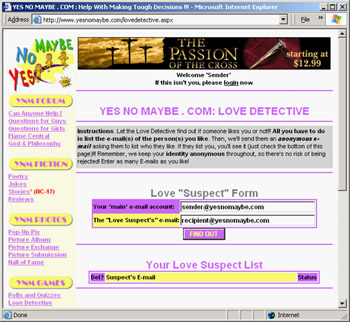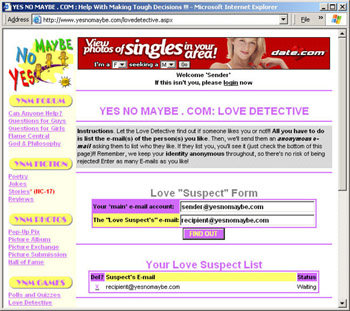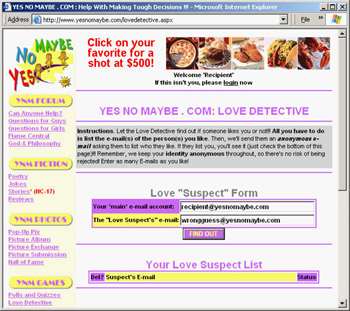Appendix B
A Detailed Account of a User Playing Social Oracle 2: The Love Detective
The Sender Using the Love Detective
The user initiates the game by clicking on the link labeled 'Love Detective,' which is located in the 'YNM GAMES' section of the menu (see lower-left corner of Figure 1-32).

Figure 1-32: YNM's home page
After the user clicks on the 'Love Detective' link, the browser displays the game's front page which consists of instructions for running the game, a form where the user can enter the required information, and a list of results which are currently empty (Figure 1-33). To run the game, the user must enter two e-mail addresses into the form, the user's own e- mail address followed by the e-mail address of the 'Love Suspect' - the person who the user is interested in. For example, in Figure 1-33, the user's e-mail address is sender@yesnomaybe.com and Love Suspect's is recipient@yesnomaybe.com.

Figure 1-33: Love Detective: Prior to entering a suspect's e-mail
The user initiates the discovery process by clicking on the 'FIND OUT' button, after which the result list ('Your Love Suspect List') displays a report containing the e-mail of the suspect and a status, which will display 'Yes' if the suspects likes the user, 'No' if the suspect does not like the user, or 'Waiting' if the Love Detective does not know (Figure 1-34). The user can then run the game again, entering more suspects ' e-mail addresses.

Figure 1-34: Love Detective: After entering a suspect's e-mail
Each time the users enters the required e-mail addresses and clicks on the 'FIND OUT' button, he or she sets off a complex chain of information events aimed at both determining whether the suspect likes the user and, concomitantly, generating new customers as a side-effect. The following section examines how the Love Detective determines whether or not a suspect likes the user and how this process results in new customers for YNM.
How the Love Detective 'Asks' a Suspect
After a user clicks the 'FIND OUT' button, a script in YNM programmatically sends an e-mail to the person whose address was specified in the suspect box, hereafter the 'recipient.' YNM sends the e-mail anonymously, from a 'Secret Admirer,' with a subject line of 'Do you like me too?' The e-mail message states that someone likes the recipient, and invites the user to visit YNM to guess who it is (Figure 1-35). As a further enticement to visit the site, the message displays three compatibility scores: dating , mental, and make-out. These scores are automatically computed as a function of the e-mail addresses entered by the user.

Figure 1-35: E-mail received by the suspect
However, if the recipient clicks on the link, he or she is not brought directly to the 'Love Detective' page. Instead, a new browser window appears on the recipient's computer displaying YNM's login page. Only after registering and logging in (not shown), can the recipient finally access the 'Love Detective.'
The Recipient Using the Love Detective
The 'Love Detective' for the recipient is exactly the same as that run by the sender. The recipient initiates the game the same way the sender does - by entering his or her e-mail address and that of the person the recipient believes sent the anonymous e-mail. For example, Figure 1-36 depicts the situation where the recipient guesses wrong - instead of entering sender@yesnomaybe.com he or she enters wrongguess@yesnomaybe.com.

Figure 1-36: Love Detective (recipient): Prior to submitting the wrong guess
Just like the sender, the recipient initiates the discovery process by clicking on the 'FIND OUT' button and the result list is updated with the suspect's e-mail and a status. Because the recipient in our example guessed wrong, the status indicates 'Waiting' (Figure 1-37) and he or she must make another guess, which is the same effect as when the sender initially entered e-mail addresses.

Figure 1-37: Love Detective (recipient): After submitting the wrong guess
However, suppose the recipient guesses correctly. Figure 1-38 depicts the recipient making a correct guess by entering the sender's e-mail address into the suspect box.

Figure 1-38: Love Detective (recipient): Prior to submitting the correct guess
After clicking the 'FIND OUT' button, a new row gets added to the result list containing the sender's e-mail address, but since the recipient guessed correctly, instead of the status displaying 'Waiting,' it displays 'Yes' (Figure 1-39).

Figure 1-39: Love Detective (recipient): After submitting the correct guess
Finally, next time the user (sender) initiates the 'Love Detective,' the status column for the recipient will indicate 'Yes,' instead of 'Waiting.'

Figure 1-40: Love Detective: What the sender sees after the recipient guesses correctly
Wrong Guesses as New Customer Generator
The above description illustrates how one of YNM's existing customers (a sender), while intentionally using the 'Love Detective' to find out if a person likes him or her, can unintentionally bring a new customer to YNM (the recipient). What may not be clear, however, is that the recipient's incorrect guessing can also unintentionally bring new customers to YNM. Recall, in our example, that the recipient initially guessed wrong, e.g., entering wrongguess@yesnomaybe.com instead of sender@yesnomaybe.com (Figure 1-37). Although a wrong guess, the Love Detective still sends an e-mail to the address (Figure 1-41), since the Love Detective does not distinguish between users who initiate it of their own volition, and those users who initiate it because they received an e-mail requesting that they use the Love Detective to guess who liked them.

Figure 1-41: E-mail sent as a result of the recipient's wrong guess
The individual whose e-mail address is associated with the 'wrong guess' receives an e-mail request to visit YNM and guess who likes them - potentially creating a new customer - and the process repeats itself.
EAN: 2147483647
Pages: 164